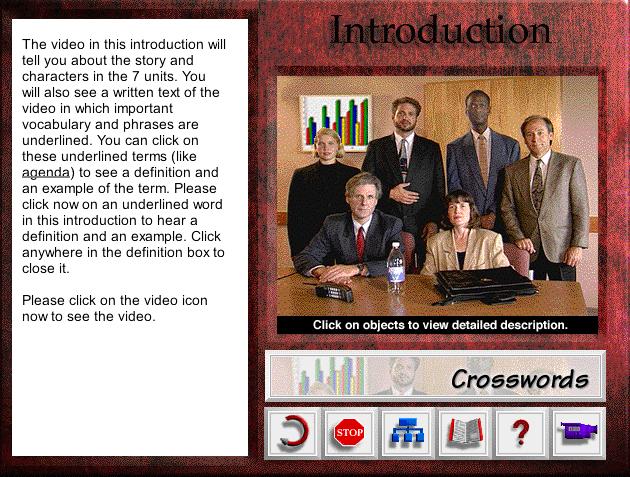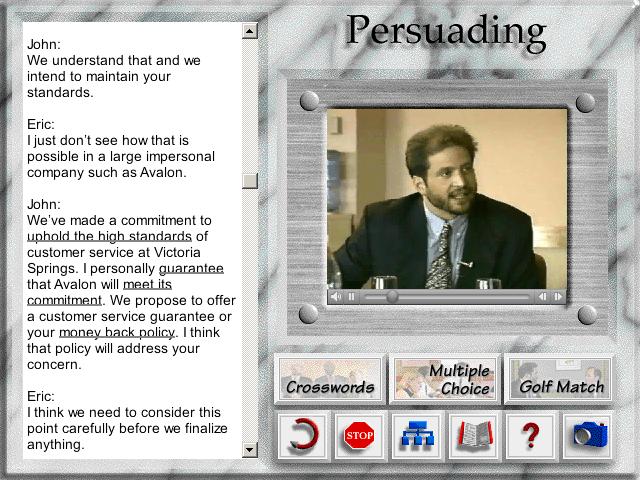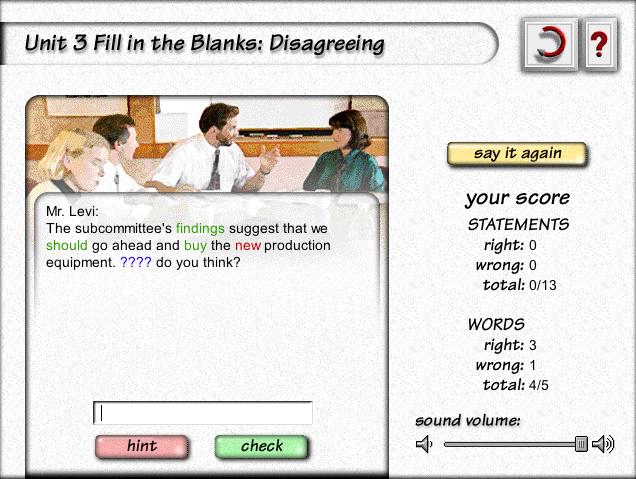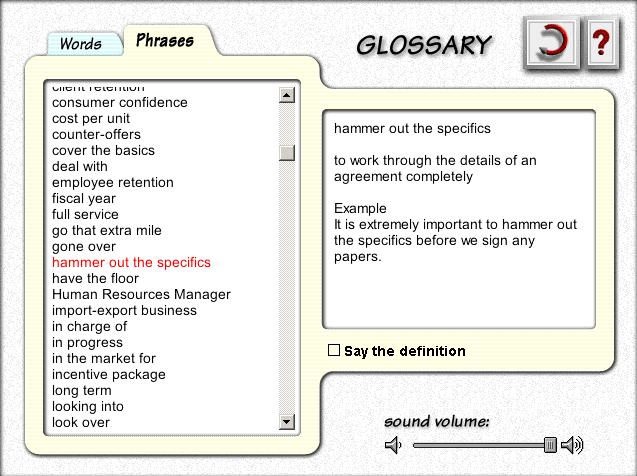 |
|
||||||||||
|
 |
|
||||||||||
|
Business English Meetings
| Title | Business English Meetings |  |
| Author | English Language Centre, University of Victoria | |
| Contact Information | ENCOMIUM Publications 2637 Erie Avenue, Suite 203 Cincinnati, OH 45208 USA (800) 234-4831, (513) 871-4377 FAX (513) 871-4312 info@encomium.com http://www.encomium.com | |
| Product Type | Language Usage Software | |
| Platform | Windows, Macintosh | |
| Minimum System Requirements: | Windows — Pentium PC; Windows 95, 98, NT 32 MB RAM; Sound Card; 8-bit color; 2x CD-ROM drive; 640x480 resolution; QuickTime 3.0 (included on CD) Macintosh — PowerPC; System 7.5 or higher; 16 MB RAM; 2xCD-ROM drive; 640x480 resolution; QuickTime 3.02 (included on CD) | |
| Price | $95.00 US | |
| ISBN | 4-900819-01-08 | |
In its own words, Business English Meetings "focuses on the language and culture of North American business meetings". Students "will learn and practice business vocabulary, phrases and idioms, and relevant expressions," and will be "introduced to appropriate body language, cultural information, communication strategies, documents and graphics".
While this is designed as an ESL/EFL program, it is so authentic, so full of information that introductory business classes with a mix of native and non-native speakers could benefit from this program. From cultural norms, foreign to everyday communication to specialized vocabulary, this program has much to offer anybody lacking experience in the business world. [-1-]
Designed for high-intermediate and advanced students, the spoken language uses authentic speed and nearly authentic enunciation with an extensive specialized vocabulary that, in some activities, requires correct spelling. An intermediate student could use the program, but it might require considerable repetition of text and activities. It would be very helpful to develop extensive background knowledge, including new vocabulary relative to the conduct of meetings, as well as a preview of some of the more important business transacted throughout the units.
First, the program offers the standard introduction of how to access it and then how to maneuver within it. The "organizational chart", a sort of flow chart, is very helpful in locating specific units or activities within units, making it easy for the teacher or the student to target specific lessons.
Seven units track the story of a business merger, including such things as: greetings, the conduct of a meeting, making business presentations, expressing disagreement, interrupting, persuasion techniques, negotiating, etc. Each unit contains:
 >
> >
>
While the program is designed as a sequenced whole, each unit could be studied individually and out of context. So, if a teacher were discussing "Negotiations," it would be possible to simply assign Unit 6, and the student would gain a considerable amount of information on just this topic.
Also, regarding program flexibility, the teacher could limit students to just one type of exercise rather than doing all of them. Similarly, given the extent of specialized vocabulary, the teacher could assign tasks related to specific vocabulary highlighted in the text but not exploited by the program. [-2-]
The issue of "successful completion" would be a standard set by the teacher. Each of the activities has a scoring system, and the teacher could suggest a minimum score before the student proceeds to the next lesson. And, as mentioned earlier, "completion" could mean nothing more than listening to one of the units and answering questions put forward by the teacher.
For an instructor with a business curriculum, this could be an excellent teaching supplement. The real strength of the program is in the video itself. Its richness includes cultural information that would be extremely difficult to communicate in lecture form. Whether it's formal/informal register, physical gestures, or personal distance, the video presents these details in a natural, non-academic manner. In most cases, the points are explained in the cultural notes, but if teachers wanted to expand the learning, they could easily target particular aspects of videos for greater elaboration.
Also, the program provides an extensive glossary that would be impossible to adequately cover with standard homework. Seeing the words in context with the ability to click on written and verbal definitions is of great assistance.
 >
>Unfortunately, the program assumes a lot of experience or knowledge of language software. "Help" options related to navigating the site offered no help in how to actually perform various activities, thus leaving it to the user to figure out how to do the crossword puzzle, unscramble sentences, play "golf," etc. through trial and error. Designed as a stand-alone program for individualized work, its lack of "help" support for each of the activities undercuts students' ability to be independent. It would cut down on student frustration and wasted time if teachers demonstrated how to perform each of the units' follow-up activities.
Given that the program is designed for advanced speakers, perhaps the frustration would be minimal; however it is disconcerting to be scoring error after error while simultaneously figuring out the mechanics of how to perform a particular exercise.
The program's feedback to the student is mixed. In terms of wrong answers: once students have entered their choices, there is no turning back, and corrections can't be made until repeating the exercise as a whole. This is an option at the end of each activity, so students can repeat each exercise as many times as necessary in order to meet their or the teacher's standards.
One very helpful feature for students is the ability to move back and forth within the video. If the problem is initial comprehension or the need to refer back to the video in order to complete an exercise, a button at the bottom of the video allows the student to control a "rewind" feature, instead of having to view the entire video from the beginning. And, as mentioned earlier, students can move back and forth in the sequenced units doing and re-doing any particular activities.
There is no way to save scores on activities, and thus no way for the teacher to "officially" monitor the success of the work. In this regard, the teacher cannot see students' scores, how many times a student repeated an exercise, nor how much time the student took to complete an exercise.
In terms of group or paired work, it's hard to imagine using this software with more than two people. Pairs could sit at the same monitor and negotiate correct answers between themselves, but due to the nature of the scoring, competition between individuals or pairs does not seem feasible. [-3-]
Beyond these limitations, the types of questions and activities offered are limited in their quality. Closed and rote, they fail to draw out higher order thinking that would have the student draw conclusions or develop inferences. Thus, any repetition of exercises has more to do with checking literal comprehension than with exploring unstated assumptions or potential consequences of actions in the videos.
As an autonomous program with unprintable screens, the teacher has no "authoring" ability to insert curriculum into the program. This is particularly important because the program's sheer density of vocabulary and speed of discourse makes it difficult to use as one stand-alone sit-down exercise. In fact, due to the breadth of information offered in Business English Meetings, it would be important to have targeted observations and a variety of follow-up classroom activities and discussions. As there was no manual or syllabus provided with my copy (and no reference to any in the software), it is assumed that teachers are on their own regarding further exploitation of the materials.
Potential activities could be as basic as expanding on specific business information and vocabulary but could be broadened to include student-written scripts for role playing of the characters or types of characters portrayed. In this context, it would be interesting to model different modes of behavior - those more reflective of the surrounding business culture as well as purposely inappropriate behaviors.
The integration of culture, literature, and daily situations into the program constitutes one of its real strengths (and perhaps weaknesses). The authors understood correctly the importance of the need for business students to understand what is appropriate and inappropriate behavior. Simple things like a "firm" vs. a "limp" handshake and the importance of direct eye contact are addressed. And much more complicated language transactions, such as how to interrupt, methods of disagreeing, and correct mores around negotiating are elaborated on.
The style described in the video is very assertive and perhaps not universal. It may be the norm in British Columbia (site of production) or New York City, but it is not necessarily common to people from more rural backgrounds or where business is conducted on a more personal basis. Thus, a student modeling the video's behavior could be viewed as ruder a pushy outsider and not someone to be trusted in many areas outside "hard core" business America.
The issue of stereotypes is one final area of concern. In two units women play a leadership role in the "meeting." In only one unit does an African-American have a role, and that role is slightly subservient - apparent enough that many would notice. But, the most glaring error is one of omission. There are no Asians or Asian-Americans in any of the units, which could be a serious shortcoming for many audiences.
In summary, Business English Meetings is an excellent program for transmitting the values and content of North American business culture. In using videos, it provides the kind of information that could never be adequately communicated by the lone teacher in front of a classroom. However, it's important for users to understand that "North American" business culture is not homogeneous and that this portrayal reflects just one business style. It would be important for teachers to draw attention to the various behavioral norms addressed in the videos and compare them with students' own experiences or perhaps provide video clips from movies and other videos in order to demonstrate other styles. [-4-]
The program's strengths:
Its weaknesses:
Business English Meetings is an excellent supplement to an Advanced English business class. In recommending the program, it's important to recognize its limitations and the need for classroom supplements and follow-up.
Tom O. Smith
Baltimore, Maryland (USA)
<tomo45@hotmail.com>
|
© Copyright rests with authors. Please cite TESL-EJ appropriately.
Editor's Note: Dashed numbers in square brackets indicate the end of each page for purposes of citation.. |
|
||||||||||